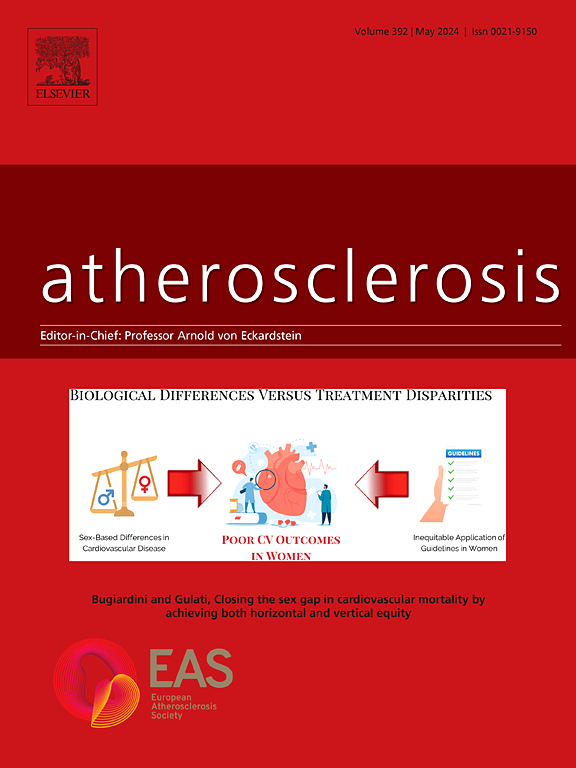低密度脂蛋白受体:新兴的转录后调节机制。
IF 4.9
2区 医学
Q1 CARDIAC & CARDIOVASCULAR SYSTEMS
引用次数: 0
摘要
胆固醇是细胞膜的重要组成部分,是哺乳动物生理中必不可少的分子。然而,肝脏胆固醇代谢失调和血浆胆固醇升高与动脉粥样硬化性心血管疾病的发生有关。因此,维持胆固醇稳态的严格调节是必不可少的,通过控制肝脏低密度脂蛋白受体(LDLR)的丰度和相关的脂蛋白清除来突出。LDLR是在20世纪70年代布朗和戈尔茨坦的开创性工作中发现的。随后他汀类药物的发展,通过LDLR途径促进肝脏对LDL的清除。20年前发现的Proprotein Convertase Subtilisin-Kexin Type 9 (PCSK9)是一种结合LDLR外结构域并促进其降解的分泌蛋白,以及PCSK9抑制剂的临床开发,为揭示控制LDLR功能和丰度的其他机制带来了努力。近年来,这导致了对控制LDLR的新的转录后和翻译后机制的识别。本综述着重于这些新兴的监管机制,并具体讨论:(1) rna结合蛋白和microrna对LDLR mRNA的调控,(2)E3泛素连接酶诱导的LDLR降解物(IDOL)和GOLIATH (RNF130)对LDLR蛋白的泛素依赖性降解,(3)asialglycoprotein receptor 1 (ASGR1)对LDLR通路的调控,(4)膜型基质金属蛋白酶(MT1-MMP)、骨形态发生蛋白1 (BMP1)和γ-分泌酶介导的LDLR外膜结构域脱落的作用。了解这些新兴机制对LDLR调控的贡献对于开发以LDLR为重点的新型降脂策略非常重要。本文章由计算机程序翻译,如有差异,请以英文原文为准。

The low-density lipoprotein receptor: Emerging post-transcriptional regulatory mechanisms
Cholesterol is a vital component of cellular membranes and is an essential molecule in mammalian physiology. Yet dysregulation of hepatic cholesterol metabolism and an increase in plasma cholesterol is linked to development of atherosclerotic cardiovascular disease. Maintaining tight regulation of cholesterol homeostasis is therefore essential, elegantly highlighted by the control of hepatic low-density lipoprotein receptor (LDLR) abundance and associated lipoprotein clearance. The LDLR was discovered in the 1970's in the seminal work of Brown and Goldstein. This was followed by the development of statins, which promote hepatic clearance of LDL via the LDLR pathway. The discovery two decades ago of Proprotein Convertase Subtilisin–Kexin Type 9 (PCSK9), a secreted protein that binds to the LDLR ectodomain and promotes its degradation, and the clinical development of PCSK9 inhibitors has ushered an effort to uncover additional mechanisms that govern the function and abundance of the LDLR. In recent years this has led to the identification of novel post-transcriptional and post-translational mechanisms that govern the LDLR. This review focuses on these emerging regulatory mechanisms and specifically discusses: (1) Regulation of the LDLR mRNA by RNA-binding proteins and microRNAs, (2) Ubiquitin-dependent degradation of the LDLR protein by the E3 ubiquitin ligases inducible degrader of the LDLR (IDOL) and GOLIATH (RNF130), (3) Control of the LDLR pathway by the asialoglycoprotein receptor 1 (ASGR1), and (4) The role of LDLR ectodomain shedding mediated by membrane-type 1 matrix metalloprotease (MT1-MMP), Bone morphogenetic protein 1 (BMP1), and γ-secretase. Understanding the contribution of these emerging mechanisms to regulation of the LDLR is important for the development of novel LDLR-focused lipid-lowering strategies.
求助全文
通过发布文献求助,成功后即可免费获取论文全文。
去求助
来源期刊

Atherosclerosis
医学-外周血管病
CiteScore
9.80
自引率
3.80%
发文量
1269
审稿时长
36 days
期刊介绍:
Atherosclerosis has an open access mirror journal Atherosclerosis: X, sharing the same aims and scope, editorial team, submission system and rigorous peer review.
Atherosclerosis brings together, from all sources, papers concerned with investigation on atherosclerosis, its risk factors and clinical manifestations. Atherosclerosis covers basic and translational, clinical and population research approaches to arterial and vascular biology and disease, as well as their risk factors including: disturbances of lipid and lipoprotein metabolism, diabetes and hypertension, thrombosis, and inflammation. The Editors are interested in original or review papers dealing with the pathogenesis, environmental, genetic and epigenetic basis, diagnosis or treatment of atherosclerosis and related diseases as well as their risk factors.
 求助内容:
求助内容: 应助结果提醒方式:
应助结果提醒方式:


